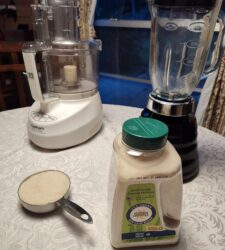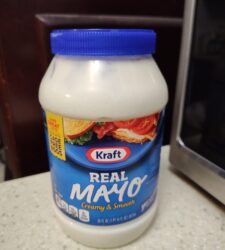Making the perfect texture cookie or cake is a matter of preference and science. Ensuring the balance in your recipe is key. This article will discuss some of these issues so you can create cookies that will please everyone.
Having an egg allergy poses a lot of challenges in cooking. To enjoy your family recipes and keep passing them down to the next generation means incorporating subtle changes that will help you maintain the integrity and flavor of your recipes. That way everyone can continue to enjoy and keep the wonderful family cooking traditions in the years to come.
Does baking soda leavening cause dense cookies?
For egg-free baking, using baking soda instead of baking powder makes the texture result in a denser cookie. Many people use baking powder in their recipes. If you’re allergic to eggs you must not use baking powder as it contains 70% powdered eggshells. Baking Powder egg content will cause a person with an egg allergy to have an allergic reaction.
Use baking soda instead. As a leavening agent, it does require an acidic ingredient to activate the release of carbon dioxide gas. This lessens the density and enhances the dough, creating a soft and fluffy chewier cookie.
Some examples of acidic ingredients are white vinegar, sour cream, applesauce, or other citrus for activation. Please note: DO NOT USE CREAM OF TARTAR! It is an acidic that is made mainly from powdered eggs.
Quick Tip: Baking Soda and your acidic ingredient(s) are the last items to add to a recipe as the carbon dioxide gas reaction will cease and your cookies (or cake) will be flatter if you don’t get it into a pre-heated oven quickly.
Tips to Change Cookie Density Techniques
Increasing the sugar content in baking creates a syrup when it heats up and absorbs different amounts of water in the recipe. By adding as little as ¼ cup (50 grams) of sugar, you can change the texture and make a sweeter cookie. Knowing which sugar to use is key.
- Brown sugar adds moisture and makes a softer, chewier cookie (it is also acidic and helps to activate the baking soda) It gives cookies that nice distinctive brown color and a richer depth of flavor
- Raw or granulated sugar makes a thinner, crunchier, crispier cookie. Use a higher ratio of white sugar versus brown sugar if you want the cookie to spread and be thin and crispy.
- Corn syrup and molasses work the same as white sugar for texture and crispness in a cookie.
Decreasing the flour content will create a thinner cookie. For a 2.5-cup flour recipe, start by reducing the flour content slowly. Suggestion: 1/8 cup (2 tablespoons), and if that is not thin enough, keep reducing by two more tablespoons which is a ¼ cup of flour. Only you can determine how crispy you desire them to be.
Butter (at room temperature) makes your cookie dough more cohesive and pliable. By increasing the butter content, you can have a chewier more cohesive cookie. Note: Melted butter will cause the cookie to be thinner and crispier.
- Suggestion: make subtle changes 2 tablespoons at a time until you reach that perfect cookie.
Baking soda with a little salt and at least one other activator will work together
- white vinegar and a heated liquid such as water or milk
- brown sugar
- Citric acid (lemon juice, apple sauce, orange juice) –It only takes about 2 1/2 teaspoons of Freshly squeezed juice.
- Buttermilk
- Plain Yogurt
- Honey
Egg Replacers – for favorable results with replacing two eggs, you should choose two different ingredients from the list below. If you choose the same ingredient for both of the eggs to be replaced, then the result can be an overpowering flavor.
Combination examples when you have to replace two eggs in a recipe
One Flaxseed egg with ¼ cup unsweetened applesauce
Milk and banana (1/4 cup of milk or yogurt, ¼ cup or less of bananas as it is an overpowering flavor and banana can add more moisture)
– Flaxseed is a great substitution for one egg. Use sparingly. (1 tablespoon flaxseed with 2.5 – 3 tablespoons of water = 1 egg equivalent. Mix it separately in a small bowl and allow to sit 5 minutes to thicken before adding to the recipe.) It is best in a recipe to replace only one egg with flaxseed. It has a great binding ability to hold your recipe together. By using a flaxseed egg with another on the list, you can keep the consistency from being tough.
– Applesauce – unsweetened all-natural applesauce will not have preservatives or added sugars. It will add some sweetness to the recipe. I use this to replace an egg in all my recipes for cookies and some of my cake recipes. (Use approximately ¼ cup)
– Milk or Sour Cream (all-natural organic milk or half-n-half), used as a replacement for one egg will add moisture and a creaminess to the integrity of the dough in your recipe (1/4 cup will replace one egg) In cakes I like to use plain Greek yogurt or milk as one of the egg replacements.
– Banana – only use ¼ cup or less. It adds consistency and sweetness; however, the banana can add additional moisture along with the overpowering flavor if you use too much.
White Vinegar – for a cake recipe, adding 1 ½ teaspoons of white vinegar to ½ cup of hot water or warm milk will activate the baking soda. Always put this in as a last ingredient. It is important, once activated, to get the cake in the preheated oven quickly so it doesn’t lose its leavening ability.
These tips are good for all your dessert ideas too. By experimenting with replacing eggs and baking powder in your recipes, you can enjoy egg-free baking and enhance the flavor for a better overall texture. Check out my desserts section to see how I incorporated them into the recipes to get some good ideas on how it can work for you too. I also have an article that can help you with changes to the recipe called “Higher-Altitude-Baking-Adjustments” in case you live in an area that is not at normal seal level.



